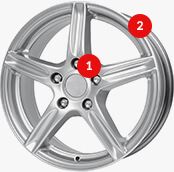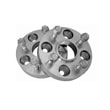Tire load index. What is it and how to read it?
Choosing the right tires for your vehicle is not only a matter of dimensions or season. Other markings also play a key role, among which the tire load index is extremely important. Thanks to this indicator, we will find out what load a given tire can safely bear. But how to read it and why is it so important? We invite you to read!
Load index – what does it mean?
The technical parameter load index is a number specifying the maximum load that the tire can carry at the maximum permissible speed . Put simply, it is information about how much weight the tire can safely support. For tires intended for different types of vehicles, from cars to trucks, the load indexes will vary. This is especially important for people who carry heavy loads, such as camping equipment, trailers or large amounts of luggage. In such situations, by using tires with an appropriate load index, we can ensure greater road safety and longer tire life. Selecting the appropriate load index is therefore the key to satisfactory tire operation and protection of the investment in new tires. It is worth paying attention to this parameter, especially if our vehicle is often loaded to its limits or we drive at high speed. The tire manufacturer's table will help you read and understand the value of this parameter.
Where is the load index on a tire?
Each tire has a number of markings on its sidewall. The letters and numbers also include a value defining the tire's load index . It is usually a two- or three-digit number that appears just before the speed symbol, i.e. a letter (e.g. 91V). If you have difficulty locating this information on the tire, it is worth checking what the symbols on car tires mean by visiting a specialist website or asking a friendly car mechanic about the markings.
How to read the load index?
Reading and understanding tire markings on your own may seem a bit complicated at first, but it's definitely worth understanding how to do it. The load index is a two- or three-digit number located on the sidewall of the tire, immediately after the size designations. For example, on a tire marked "205/55R16 91V", the number "91" represents the load index.
This specific number represents the maximum load that the tire can safely carry at maximum speed. However, it is worth remembering that the number itself does not indicate the exact weight. To determine exactly how many kilograms a given tire load index corresponds to, it is worth checking the load index table, available from tire manufacturers or specialist industry sources. If the tire markings show the index 91, it means that the tires can support a load of up to 615 kg. A specialized table shows the load capacity for all load indexes.
Don't assume that a higher load index automatically means a better tire. Choosing a tire with the appropriate load index should be based on the specification of a given vehicle and the typical loads encountered during everyday driving. Too low an index can lead to premature tire wear and safety problems , while an index that is too high may not provide any additional benefits and may even affect driving comfort.

Why is the load index important for safety?
- Puncture protection. Tires with the appropriate load index are less susceptible to punctures. When a tire is overloaded, the thinner parts of the tire can wear out faster and become more susceptible to punctures.
- Driving stability. Using tires with the appropriate load index guarantees better vehicle stability, especially during high-speed maneuvers or when the car is heavily loaded.
- Predictable tire behavior. Tires that are not overloaded and meet vehicle specifications behave more predictably in a variety of driving conditions.
- Longer tire life. An incorrect load index can shorten the life of the tire. Tires loaded beyond their load-bearing capacity may experience excessive wear, requiring tire replacement sooner.
- Fuel saving. Tires that are properly matched to the vehicle's load can help optimize fuel economy. Overloaded tires can increase rolling resistance, which leads to higher fuel consumption.
Understanding and following tire load index markings is an important step towards ensuring road safety. Not only does this help protect the tire itself from premature wear, but it also plays a key role in ensuring driving stability and safety. By choosing tires with the right load index for your vehicle and driving style, you can drive more confidently and calmly , knowing that your car is properly equipped.
Appropriate tire markings and awareness of their importance are the key to safe driving. The load index is one of the most important indicators that every driver should know and understand. Let us remember that the right tires are not only about driving comfort, but above all our safety on the road.

















